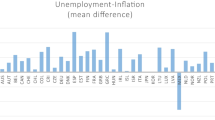Abstract
This paper reconsiders the familiar Ramsey model of optimal saving. This model is modified with two respects: direct spillovers (positive or negative) of capital on utility and penalties for changes of consumption. It will be shown that these two modifications may substantially change the stability properties of an optimal programme if capital provides utility directly (in addition to indirectly through production). More precisely, complex strategies such as (stable) limit cycles or even unstable policies may be optimal. Adjustment costs must be sufficiently high in order to obtain stable limit cycles (or even exploding spirals). This is quite surprising because large adjustment costs are expected to smooth intertemporal strategies.
Similar content being viewed by others
References
Amir, R., Mirman, L. J., and Perkins, W. R. (1991): “One-Sector Non Classical Optimal Growth: Optimality Conditions and Comparative Dynamics”.International Economic Review 32: 625–644.
Becker, G. S., and Murphy, K. M. (1988): “A Theory of Rational Addiction”.Journal of Political Economy 96: 675–700.
Benhabib, J., and Nishimura, K. (1979): “The Hopf Bifurcation and the Existence and Stability of Closed Orbits in Multisector Models of Economic Growth”.Journal of Economic Theory 21: 421–444.
Benhabib, J., and Rustichini, A. (1990): “Equilibrium Cycling with Small Discounting”.Journal of Economic Theory 52: 423–432.
Brock, W. (1974): “Money and Growth: The Case of Long Run Perfect Fore-sight”.International Economic Review 15: 750–777.
Dockner, E. (1985): “Local Stability Analysis in Optimal Control Problems with Two State Variables”. InOptimal Control Theory and Economic Analysis, vol. 2, edited by G. Feichtinger. Amsterdam: North-Holland.
Dockner, E., and Feichtinger, G. (1993): “Cyclical Consumption Patterns and Rational Addiction”.American Economic Review 83: 256–263.
Guckenheimer, J., and Holmes, P. (1983):Nonlinear Oscillations, Dynamical Systems, and Bifurcation of Vector Fields. New York: Springer.
Hadley, G., and Kemp, M. C. (1971):Variational Methods in Economics. Amsterdam: North-Holland.
Hartl, R. F. (1987): “A Simple Proof of the Monotonicity of the State Trajectories in Autonomous Control Problems”.Journal of Economic Theory 41: 211–215.
Hassard, B. D., Kazarinoff, N. D., and Wan, Y. H. (1981):Theory and Application of Hopf Bifurcation. (London Mathematical Society Lecture Notes 41) Cambridge: Cambridge University Press.
Kamien, M. I., and Schwartz, N. L. (1981):Dynamic Optimization: The Calculus of Variations and Optimal Control in Economics and Management. Amsterdam: North-Holland.
Konrad, K. A. (1992): “Wealth Seeking Reconsidered”.Journal of Economic Behavior and Organizations 18: 215–227.
Kurz, M. (1968): “Optimal Economic Growth and Wealth Effects”.International Economic Review 9: 348–357.
Matsuyama, K. (1991): “Endogenizing Price Fluctuations in an Optimizing Model of a Monetary Economy”.Econometrica 59: 1617–1631.
Ramsey, F. P. (1928): “A Mathematical Theory of Saving”.Economic Journal 38: 543–559.
Ryder, H. E. jr., and Heal, G. M. (1973): “Optimal Growth with Intertemporally Dependent Preferences”.Review of Economic Studies 40: 1–31.
Thurow, L. D. (1992): “Perspectives of US Economic Policy under the New Government.” Mimeo, presentation at the Bank Austria, November 24, 1992.
van der Ploeg, F., and Withagen, C. (1991): “Pollution Control and the Ramsey Problem”.Environmental and Resource Economics 1: 215–236.
Wirl, F. (1992): “Cyclical Strategies in Two-Dimensional Optimal Control Models: Necessary Conditions and Existence”.Annals of Operations Research 37: 345–356.
Author information
Authors and Affiliations
Rights and permissions
About this article
Cite this article
Wirl, F. The ramsey model revisited: The optimality of cyclical consumption and growth. Zeitschr. f. Nationalökonomie 60, 81–98 (1994). https://doi.org/10.1007/BF01228026
Received:
Revised:
Issue Date:
DOI: https://doi.org/10.1007/BF01228026




